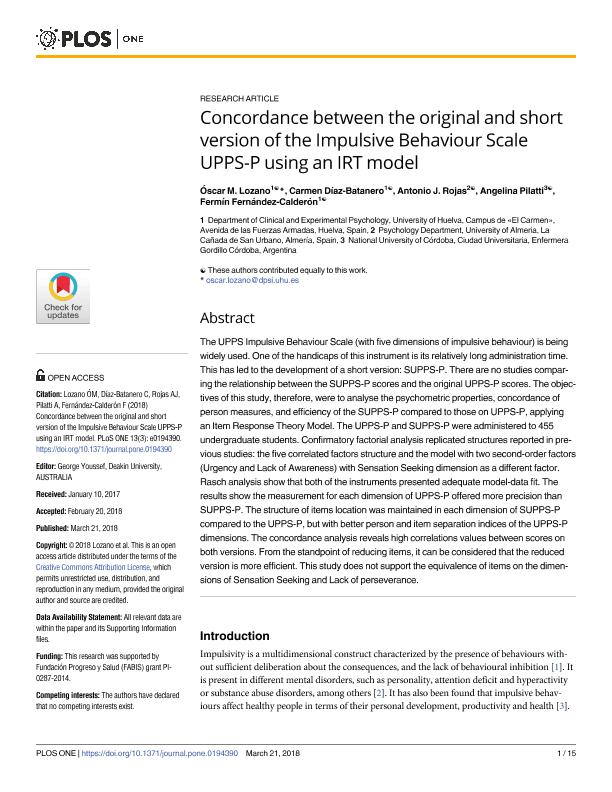Mostrar el registro sencillo del ítem
dc.contributor.author
Lozano, Óscar M.
dc.contributor.author
Díaz-Batanero, Carmen
dc.contributor.author
Rojas, Antonio J.
dc.contributor.author
Pilatti, Angelina

dc.contributor.author
Fernández Calderón, Fermín

dc.date.available
2021-03-08T20:35:50Z
dc.date.issued
2018-03
dc.identifier.citation
Lozano, Óscar M.; Díaz-Batanero, Carmen; Rojas, Antonio J.; Pilatti, Angelina; Fernández Calderón, Fermín; Concordance between the original and short version of the impulsive behaviour scale UPPS-P using an IRT model; Public Library of Science; Plos One; 13; 3; 3-2018
dc.identifier.issn
1932-6203
dc.identifier.uri
http://hdl.handle.net/11336/127782
dc.description.abstract
The UPPS Impulsive Behaviour Scale (with five dimensions of impulsive behaviour) is being widely used. One of the handicaps of this instrument is its relatively long administration time. This has led to the development of a short version: SUPPS-P. There are no studies comparing the relationship between the SUPPS-P scores and the original UPPS-P scores. The objectives of this study, therefore, were to analyse the psychometric properties, concordance of person measures, and efficiency of the SUPPS-P compared to those on UPPS-P, applying an Item Response Theory Model. The UPPS-P and SUPPS-P were administered to 455 undergraduate students. Confirmatory factorial analysis replicated structures reported in previous studies: the five correlated factors structure and the model with two second-order factors (Urgency and Lack of Awareness) with Sensation Seeking dimension as a different factor. Rasch analysis show that both of the instruments presented adequate model-data fit. The results show the measurement for each dimension of UPPS-P offered more precision than SUPPS-P. The structure of items location was maintained in each dimension of SUPPS-P compared to the UPPS-P, but with better person and item separation indices of the UPPS-P dimensions. The concordance analysis reveals high correlations values between scores on both versions. From the standpoint of reducing items, it can be considered that the reduced version is more efficient. This study does not support the equivalence of items on the dimensions of Sensation Seeking and Lack of perseverance.
dc.format
application/pdf
dc.language.iso
eng
dc.publisher
Public Library of Science

dc.rights
info:eu-repo/semantics/openAccess
dc.rights.uri
https://creativecommons.org/licenses/by-nc-sa/2.5/ar/
dc.subject
IMPULSIVITY
dc.subject
PSYCHOMETRICS
dc.subject
RASCH MODEL
dc.subject
UPPS-O
dc.subject.classification
Otras Psicología

dc.subject.classification
Psicología

dc.subject.classification
CIENCIAS SOCIALES

dc.title
Concordance between the original and short version of the impulsive behaviour scale UPPS-P using an IRT model
dc.type
info:eu-repo/semantics/article
dc.type
info:ar-repo/semantics/artículo
dc.type
info:eu-repo/semantics/publishedVersion
dc.date.updated
2021-02-10T20:47:31Z
dc.journal.volume
13
dc.journal.number
3
dc.journal.pais
Estados Unidos

dc.journal.ciudad
San Francisco
dc.description.fil
Fil: Lozano, Óscar M.. Universidad de Huelva; España
dc.description.fil
Fil: Díaz-Batanero, Carmen. Universidad de Huelva; España
dc.description.fil
Fil: Rojas, Antonio J.. Universidad de Almería; España
dc.description.fil
Fil: Pilatti, Angelina. Universidad Nacional de Córdoba. Facultad de Psicología; Argentina. Universidad Nacional de Córdoba. Instituto de Investigaciones Psicológicas. - Consejo Nacional de Investigaciones Científicas y Técnicas. Centro Científico Tecnológico Conicet - Córdoba. Instituto de Investigaciones Psicológicas; Argentina
dc.description.fil
Fil: Fernández Calderón, Fermín. Universidad de Huelva; España
dc.journal.title
Plos One

dc.relation.alternativeid
info:eu-repo/semantics/altIdentifier/url/https://journals.plos.org/plosone/article?id=10.1371/journal.pone.0194390
dc.relation.alternativeid
info:eu-repo/semantics/altIdentifier/doi/http://dx.doi.org/10.1371/journal.pone.0194390
Archivos asociados
